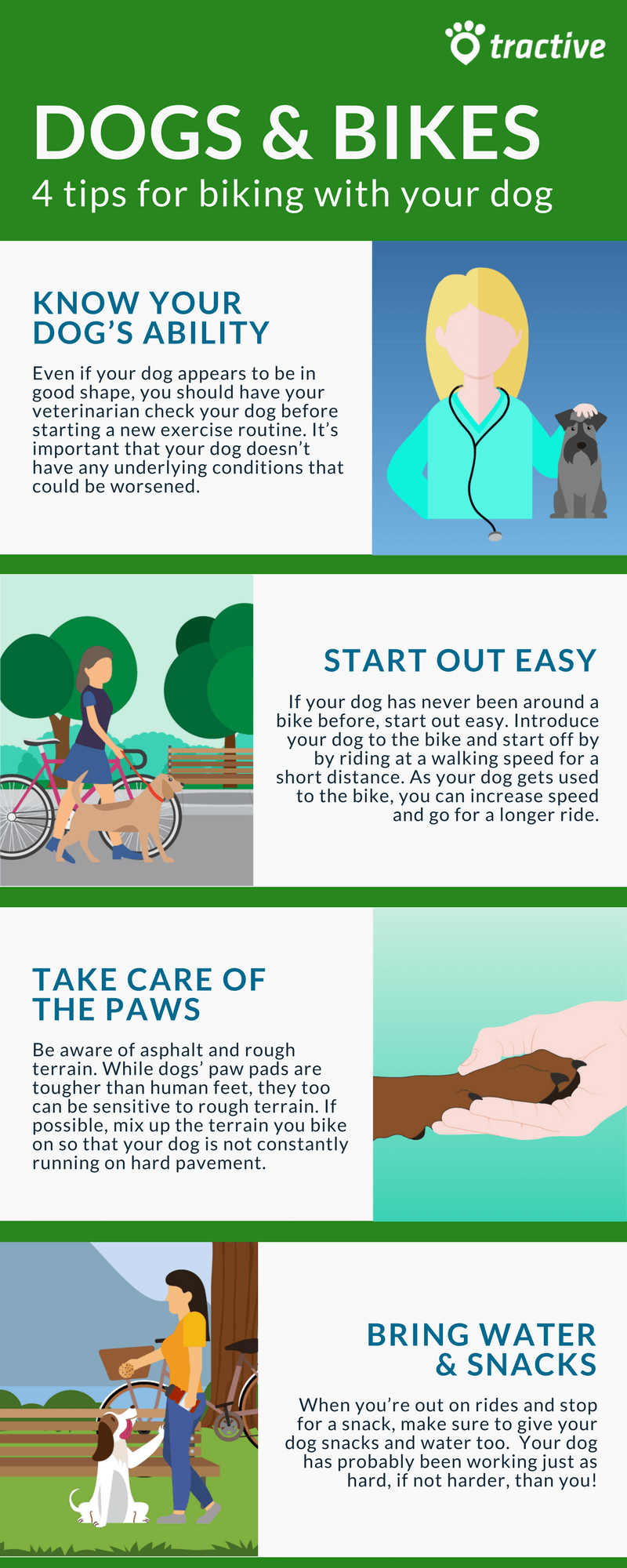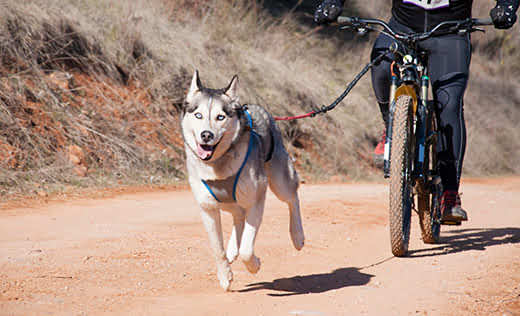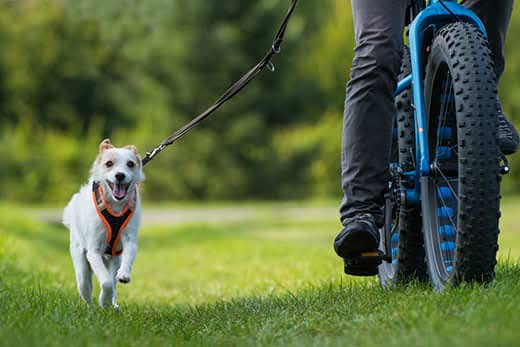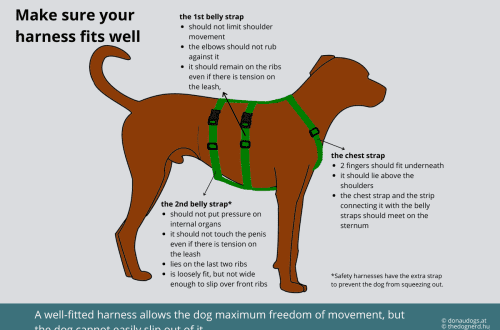
How to ride a bike with your dog: tips for a successful ride
The pet will be an excellent companion during a bike ride. How to understand that a four-legged friend is ready for such an adventure and how to prepare a dog for a bike?

Contents
Dog breeds for cycling
Just like people, some pets love to spend time outdoors and explore paths and paths. Some breeds naturally need high-intensity exercise and wide open spaces in parks.
The IRideUp mountain bike travel guide reports that Australian Cattle Dogs, Border Collies, Labrador Retrievers, Hungarian Vizslas and Weimaraners do well on mountain bike trails with their owners.
Experts also note that the best companions for cycling are dogs that are well trained to follow verbal commands.
The owner will often need to use the “come to me” command to keep the pet on the path and move next to the bike, as well as away from other cyclists and pedestrians. If your four-legged friend is constantly running away, you can try teaching him the “left” and “right” commands to help him stay on track and avoid potential hazards, such as ravines or sharp rocks.
The owner has a chance to catch his breath while riding down the hill, but the dog will have to run every minute of the 15-kilometer ride. For this reason, it is important to consider the physical preparation of the dog.
Is it easy for her to walk around the neighborhood? Are her joints, paws, paw pads okay? And what about the heart? When preparing for a bike race, it is important to get the approval of a veterinarian. He will tell you if you can take your pet on long walks of high intensity, such as cycling.
In addition, if the dog likes to constantly stop to sniff everything properly, is easily distracted by wildlife or people, he will not be the best companion for cycling.
Finally, if the dog stops abruptly, it may injure or injure the owner..
Riding a bike with a dog: the first trip
If the pet is mentally and physically ready for a joint bike ride, in which he will have to run next to the owner, it’s time to resolve a few issues. According to cycling enthusiasts from IRideUp and Bicycling Magazine, the following points need to be considered:
- Is the weather suitable for the trip? The paws of the pet will touch the ground all the time. But what if it’s too hot, too cold, or too slippery for your dog to enjoy his run?
- Does your pet tolerate extreme temperatures well? The owner can warm up and put the dog in a tight-fitting jacket or a cooling vest. But will she really be comfortable with it? Perhaps to make the walk more comfortable for the dog, you should make it shorter.
- Where does your dog like to run? Teaching your dog to run in front of or behind a bike may require a little guidance from an experienced handler. He will teach commands to ensure that the pet does not get too close or too far away.
- How far can a pet run? To keep up with the bike, the dog will have to run at a medium or fast pace most of the time. This is quite difficult, so you need to make several test runs in the area or local park away from traffic for 10-15 minutes. Then you can go on the first official walk along the route of 2-3 kilometers to assess how the dog is feeling in general. In the case of regular cycling, it is important to remember that training should also become constant.
- When is the best time to take these walks? In order to avoid unnecessary stress for yourself and your pet, it is better to choose more deserted paths on a weekday to gradually try out the cycling partnership. On weekends and holidays, there will be more people and other animals around and, accordingly, more distractions.
After several trial runs and one or two full but short trips, you can gradually increase the duration of the route. Healthy and flexible young dogs will be able to handle long runs better than dogs that have health problems or are no longer so young.
It is important to pay attention to the signals your dog is sending you. If she’s constantly panting, lying down to take a break, or demanding attention, she probably needs a break. It is better to finish the walk and go home.
What to bring for a bike ride with your dog
When choosing a place for a bike ride, it is important to know the rules and regulations for cyclists with pets. Some parks designate areas where dogs can be let off the leash, while others may require that pets be kept on a leash at all times.
For cycling on a leash, you need to choose one that is securely attached to the bike. If the walk will be without a leash, you need to make sure that the pet is wearing an address tag and a bright vest, harness or collar that will help you quickly find the dog if it runs away.
The American Travel Society and REI recommend taking the following items with you on your dog bike ride:

- bottled water;
- treats for training;
- dog food if the walk is long;
- snacks or meals for the owner himself;
- folding travel bowls;
- first aid kits for dogs and people;
- flashlight for evening walks;
- clothes – a raincoat, fleece, as well as a sweater, vest and booties for the dog;
- mobile phone with the number of a veterinarian;
- dog waste bags;
- small towel.
Accessories can be put in your backpack or a special backpack for the dog. REI recommends limiting your pet’s “luggage” weight to 25% of their body weight. So, for a Labrador Retriever weighing about 32 kg, equipment should weigh no more than 8 kg.
During the first few runs, the backpack should be as light as possible. It will take your dog some time to get used to wearing the new accessory.
A few final tips for cyclist owners
Riding a bike with a dog is a lot of fun. But not all four-legged friends love it. If your pet prefers leisurely walks around the neighborhood, tossing a ball in a dog park, or running through an obstacle course in the backyard, you should respect his wishes. Like people, a dog’s interests may differ from those of its owner.
In addition, remember that it is important to teach your pet to interact with other pets, cyclists and walkers. For safety, the dog must be trained to respond quickly to the “come” command. It is necessary to constantly supervise the pet so that the walk is safe for everyone.
The few days that it takes to practice the skills needed to cycle with a dog will be enough to figure out if this hobby is suitable for a pet. You can also ask a trainer for advice and a veterinarian for advice on how to keep your four-legged friend healthy and safe during these outdoor activities.
Perhaps this new activity will appeal to everyone. And then the owner and the pet will have more joint hobbies.





